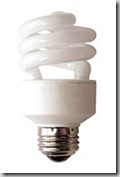Update on CFLs...
 CFL Light Bulbs? Had a CFL energy efficient light bulb break the other day. Luckily it broke inside a glass fixture cover, everything was contained except a bit of the gas. None the less I did get a headache and begin to sweat as a result of breathing it. Went online to find out more about them.
CFL Light Bulbs? Had a CFL energy efficient light bulb break the other day. Luckily it broke inside a glass fixture cover, everything was contained except a bit of the gas. None the less I did get a headache and begin to sweat as a result of breathing it. Went online to find out more about them.
Like all florescent bulbs CFLs contain small amounts of mercury and require special hazardous waste handling when they burnout or break. Mercury is a potent neurotoxin, and is especially dangerous for children and fetuses. Some states require that CFLs be taken to a recycling center and not thrown into the trash. EPA states, 'If you improperly dispose of products with mercury in them, they may break and release mercury vapors which are harmful to human and ecological health.' When they break there are very specific instructions for cleanup which I didn't know about. Here they are...
EPA's recommendations for broken CFL bulb clean up
Before Clean-up: Air Out the Room
- Have people and pets leave the room, and don't let anyone walk through the breakage area on their way out.
- Open a window and leave the room for 15 minutes or more.
- Shut off the central forced-air heating/air conditioning system, if you have one.
Clean-Up Steps for Hard Surfaces
- Carefully scoop up glass pieces and powder using stiff paper or cardboard and place them in a glass jar with metal lid (such as a canning jar) or in a sealed plastic bag.
- Use sticky tape, such as duct tape, to pick up any remaining small glass fragments and powder.
- Wipe the area clean with damp paper towels or disposable wet wipes. Place towels in the glass jar or plastic bag.
- Do not use a vacuum or broom to clean up the broken bulb on hard surfaces.
Clean-up Steps for Carpeting or Rug
- Carefully pick up glass fragments and place them in a glass jar with metal lid (such as a canning jar) or in a sealed plastic bag.
- Use sticky tape, such as duct tape, to pick up any remaining small glass fragments and powder.
- If vacuuming is needed after all visible materials are removed, vacuum the area where the bulb was broken.
- Remove the vacuum bag (or empty and wipe the canister), and put the bag or vacuum debris in a sealed plastic bag.
Clean-up Steps for Clothing, Bedding and Other Soft Materials
- If clothing or bedding materials come in direct contact with broken glass or mercury-containing powder from inside the bulb that may stick to the fabric, the clothing or bedding should be thrown away. Do not wash such clothing or bedding because mercury fragments in the clothing may contaminate the machine and/or pollute sewage.
- You can, however, wash clothing or other materials that have been exposed to the mercury vapor from a broken CFL, such as the clothing you are wearing when you cleaned up the broken CFL, as long as that clothing has not come into direct contact with the materials from the broken bulb.
- If shoes come into direct contact with broken glass or mercury-containing powder from the bulb, wipe them off with damp paper towels or disposable wet wipes. Place the towels or wipes in a glass jar or plastic bag for disposal.
Disposal of Clean-up Materials
- Immediately place all clean-up materials outdoors in a trash container or protected area for the next normal trash pickup.
- Wash your hands after disposing of the jars or plastic bags containing clean-up materials.
- Check with your local or state government about disposal requirements in your specific area. Some states do not allow such trash disposal. Instead, they require that broken and unbroken mercury-containing bulbs be taken to a local recycling center.
Future Cleaning of Carpeting or Rug: Air Out the Room During and After Vacuuming
- The next several times you vacuum, shut off the central forced-air heating/air conditioning system and open a window before vacuuming.
- Keep the central heating/air conditioning system shut off and the window open for at least 15 minutes after vacuuming is completed.
This is frightening, especially since I'd imagine most folks don't know about it. I didn't! Mercury is extremely toxic! What doesn't make sense to me is why? Knowing the toxicity of mercury, why make bulbs utilizing even a little bit for sale on such a large scale? A lot of little bits add up to... well, a big toxic mess. It got me really wondering does the end justify the means?
My conclusion... NO! I replaced all of my CFLs with incandescent bulbs again, because I don't want the potential contamination of myself, my family, my pets or the earth. I'd rather keep the lights turned off as much as possible and use candles.
After reading all of this I sure won't recommend using CFL bulbs again. Yes, they help reduce mercury from coal burning power plants which is good. But potentially poisoning myself in the process isn't a good trade off. Maybe I'm over reacting here... but the way I see it 'forewarned is forearmed'.
Perhaps a better use for all the money spent on CFLs (advertising and sales) would have been to upgrade the electric power plants to solar, wind, water or other eco-friendly methods. Then there wouldn't be mercury from either coal or florescent bulbs poisoning us and our beautiful earth.
A thought... according to the U.S Census Bureau Population Clocks as of August 20, 2008 there are 304,922,151 people in the U.S. If every person bought 1 CFL at roughly $6.00 each that comes to $1,829,532,906. That is almost 2 billion dollars and that's a conservative figure. If that money were spent on upgrading power plants we would be much further along in the process of our environmental stewardship.
Plus, there's got to be a safer, more eco-friendly, cheaper lighting solution! I'll let you know what I find.

No comments:
Post a Comment